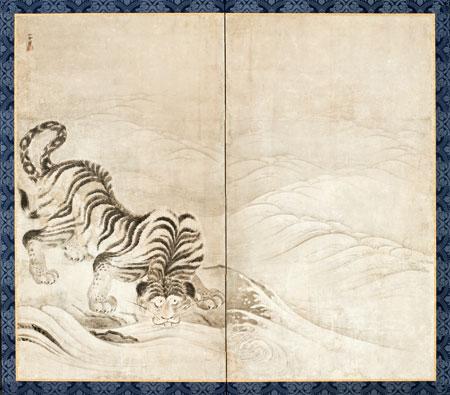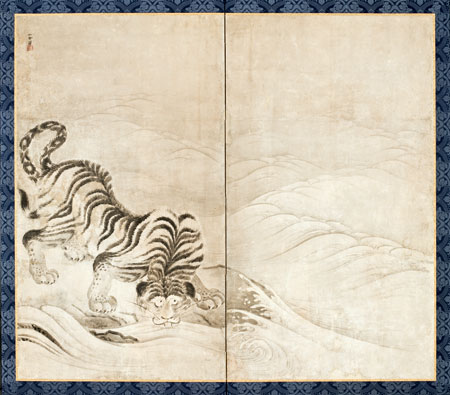When I stopped by to visit Japanese Art curator Robert T. Singer and see the newly acquired screen by seventeenth-century artist Kano Sansetsu, he was second-guessing the title he’d given the work: Tiger Drinking from a Raging River. “Is ‘raging’ too strong?” he asked me. “Should it be a roiling river?”
The fact is there was no official title for this work prior to its acquisition. The two-panel screen was discovered in 2006 in an English country house. Rob estimates that it might have been in England for at least the last 100 years. When it was brought back to Japan, the NHK (think “the BBC of Japan”) documented its arrival and followed the scholar Tsuji Nobuo as he looked closely at the screen for the first time, to determine whether or not it was a genuine work by the great Sansetsu. Here’s a clip from the broadcast.
[vimeo vimeo.com/11975579]
You can see Professor Tsuji set a book next to the screen, comparing the style of the tiger to another work by Sansetsu. Rob translated for me that, after careful consideration, Professor Tsuji declares the work “without doubt, a genuine work by Sansetsu.” (It doesn’t hurt that the artist’s signature is in the top left corner.)
In the four years since its discovery, Sansetsu’s screen has been published in numerous textbooks on Japanese art. In one book it was titled, simply, Tiger. In another it was more elaborately labeled Tiger Drinking Water. Rob felt that neither was appropriately descriptive. This was a tiger daringly stealing a sip before the river water might splash or drench it. You can see from its curved back and rolling eyes that it is apprehensive. Rob wanted to get the dangerous nature of the image across in the title, though now he wondered whether he’d overstated it with “raging.”
Then again, one might ask: Is this a tiger? Is that a river?
The answers are a qualified yes and probably. In the seventeenth century there were no tigers in Japan. Though the animal loomed large in the Eastern zodiac and yin-yang cosmology—both concepts imported from China, where large cats roam—Japanese artists depended on descriptions from their more well-traveled peers. So, this tiger has the paws and tail of a leopard. (We also have a thirteenth-century elephant—another animal that didn’t exist in Japan—which looks a bit more like a puppy, with a short trunk and, as Rob describes, “the butt of a water buffalo.”)
Too, what river has waves like that? Is this tiger sipping from the ocean? “I don’t think so,” said Rob. “What animals drink salt water?” Even if Sansetsu didn’t know the accurate details of the tiger’s paws, he would not have turned the image into total fantasy. So, it is a tiger, and it drinks from a river. Thus we return to that last nagging word, raging. Finally Rob decided that it was appropriate. It’s an adversarial image—the river is squarely on one panel of the screen, the tiger on the other; the tiger is poised on a rocky edge as it nips at the water, and the waves are many—they stretch into the distance almost like a mountain range. Were you take a raft to that river, “raging waters” would probably describe your experience.




